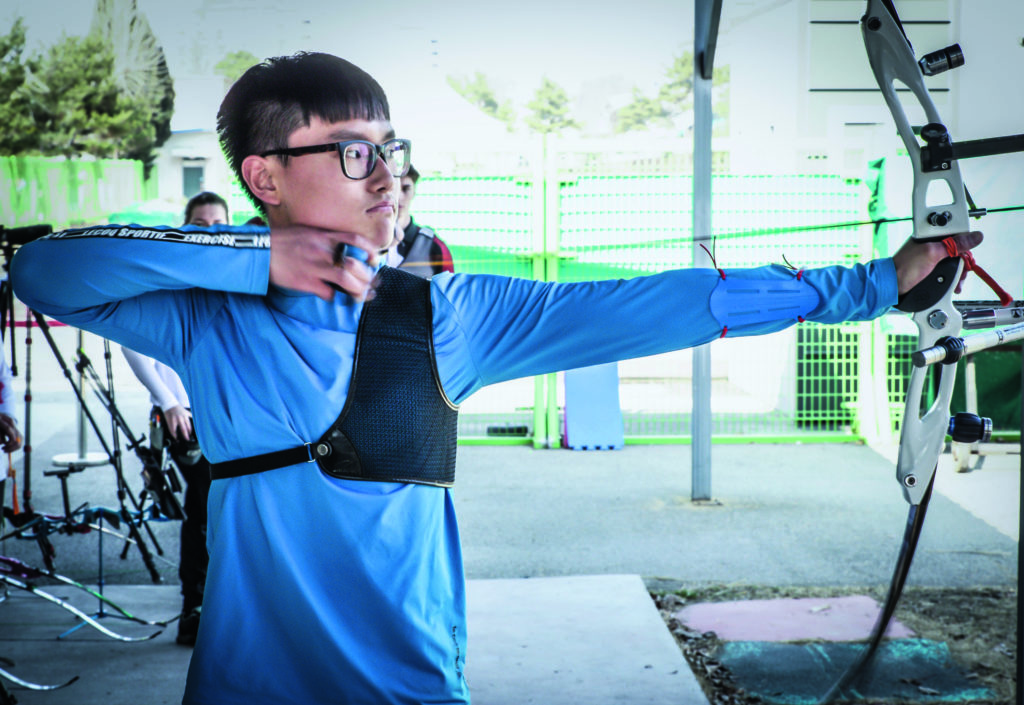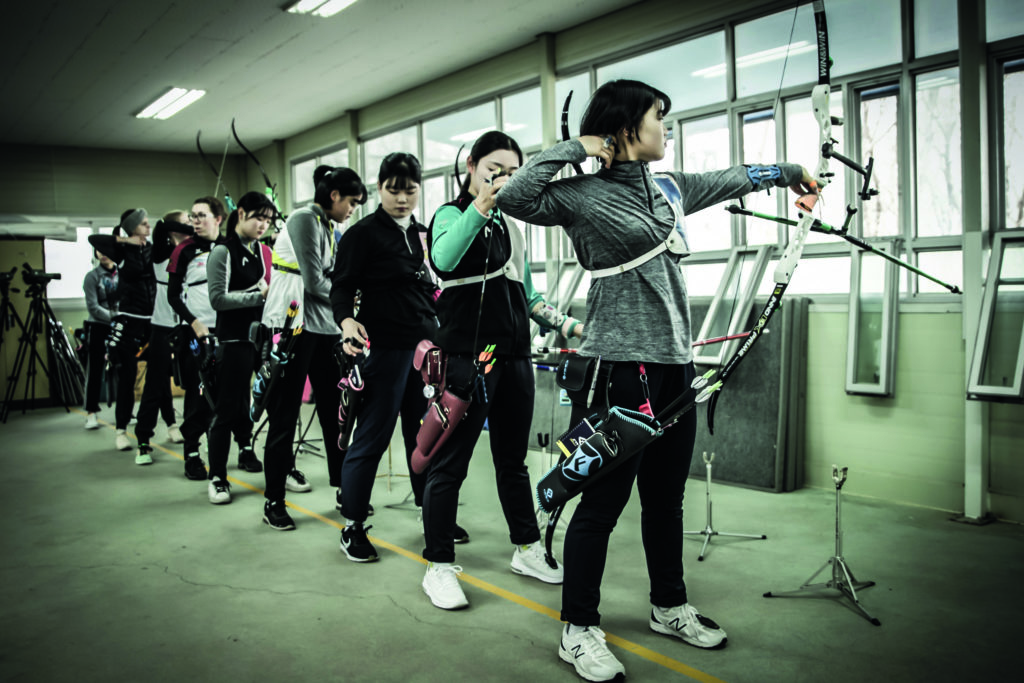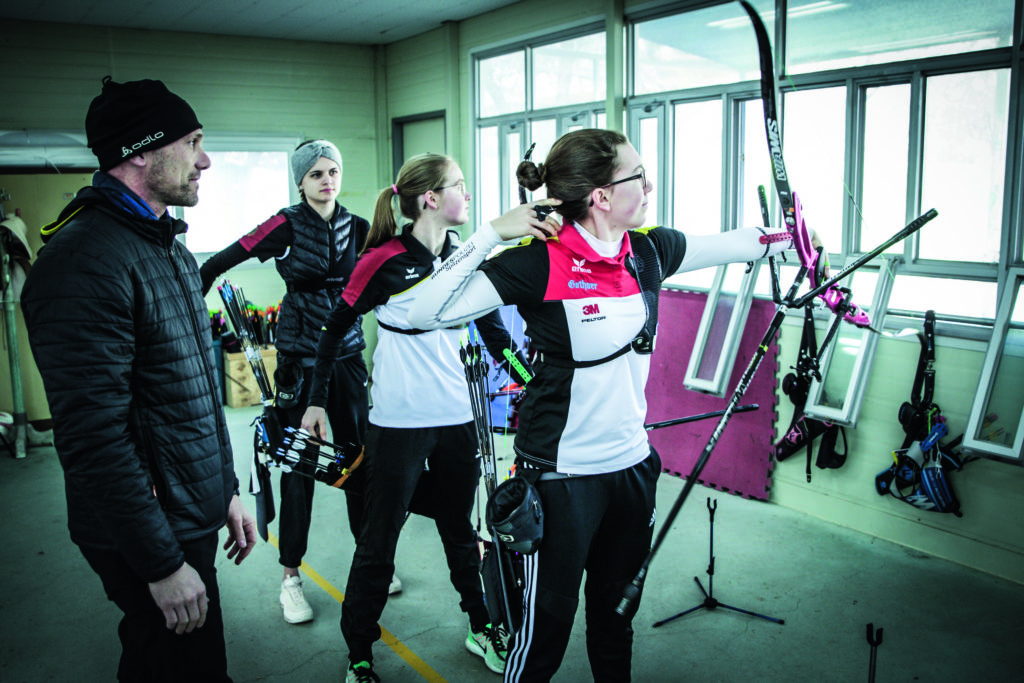Marc Dellenbach says that the key to Korean archery dominance is in their schools.

Marc Dellenbach was the French Olympic team coach from 2004-2016, and is now the national junior head coach of Germany. Early in 2019 he took a German junior team to train in Korea, one of many visits he has made over the years. Here he shares his thoughts on their school system – and what we can learn from it.
At the beginning of March, six archers and two coaches from the German youth national team were lucky enough to go to Korea. Over a week they shared training with youth archers (15-18 years old) in the heart of the youth Korean system; a sport-specialist middle and high school in Daejeon, 150km south of Seoul.
The first time I went to Korea was in 2003. At that time I wanted to understand why the country was so strong over the previous 20 years. 16 years after that, nearly nothing has changed and Koreans are still the best in the world with the four gold medals at Rio Olympics – the first time in Olympic archery history that this happened.
Let’s try to analyse the key points of these amazing successes. Before 1980, there was only traditional archery in Korea. In the early 80s, when they won the bid for the Seoul Olympic Games of 1988, the government wanted to have success and decide to fund several sports to get results and to show all over the world the power of the country.
Four people originally started to work on this project, including Kisik Lee (now Team USA coach) and Park Kyung Rae, who later became director of the Win & Win manufacturing company.
They invested in the education system and created schools for beginners, who can now train every afternoon after school with professional coaches. Indeed, the strength of the system is really based on archery at school.
South Korea is composed of nine regions and seven major towns. In each of this 16 areas there is primary, middle, and high schools, but also university and business teams where it’s possible to practice professional archery.
Primary school is the level where there are most archers, although only a few primary schools participate in each region (it is not the case that every Korean schoolchild tries archery, far from it). Every year only the best can continue to practice and make a step forward. The goal is to become a champion – not to find a new hobby.
This means, for each area, for both men and women there are:
- 2 or 3 primary schools (6 to 10 archers) 256 – 480
- 1 middle school (6 to 8 archers) 96 – 128
- 1 high school (6 to 8 archers) 96 – 128
- 1 university (6 to 8 archers) 96 – 128
- 1 business team (4 to 6 archers) 64 – 96
All in all, the total amount of young archers training is around 1500 – that compares well to many other countries around the world. But the big difference is that all the archers train every day to try to become a champion. Leisure archery doesn’t exist in Korea – there’s no place and no clubs to practice Olympic archery.
Korean coaches think that the most important thing is that the “archer has to develop a technique, such that the bow and arrow will be a part of them.” To achieve this, only a great deal of training over many years can help someone to reach this goal.
I asked the coaches from Daejeon how many arrows an archer has to shoot per day. They answered that to develop a good technique, youths have to shoot 400 or 500 arrows per day, and sometimes they can shoot up to 1000 arrows per day.
They train six days per week; so this works out to around 100,000 arrows per year. They work on technique between October and March. After that, between April and October they have two competitions every month; the last competition is the Korean National Championships.
A key feature of the system, unlike almost anywhere else, is that all schools have facilities to shoot outdoors from indoor to practice long distance all over the year.

Archery is not an indoor sport. They don’t practice at 18 metres apart from a handful of archers on the business teams. The high school archers are actually likely to shoot the most, because they want to go to a business team or university.
Going to university is very expensive (over €10,000 a year), but if they are selected by an archery team it’s free. Great motivation to work hard.
High technical requirements
Since the beginning of the Olympic project, the Koreans have understood that to develop high level skills in archery you need to improve and lock down your technique, and for this you have to shoot a lot of arrows.
In the 1980s they studied American and Russian techniques, who were the top archery nations at that time, and made their own model based on a good T position, line, timing and – most important of all – repetition.
The priority is to teach good basics from the beginning: “A good archer is an archer who knows exactly what he has to do to shoot a good arrow.” In the past a beginner archer could spend six months just using a theraband working to fix the right position, before they even pick up a bow.
Now it’s less, but they continue to teach with theraband and trainer bows without shooting, just to develop good form – and always under the eye of the coach.
They also use mirrors to repeat and correct the position. When they start shooting, every time it will be ten or more arrows per end at short distance to repeat and lock in the technique. They also continue to practice the full WA1440 round (four distances), because it’s more difficult and it helps archers to become better.
Professional coaches
All coaches in Korea, without exception, are professional. They are all former archers, with a minimum of five or six years in the system, and most of them are not champions because: “champions don’t know problems archers can have during their development. They are not able to find solutions because they can’t understand what happening, because they didn’t have these problems when they were archers”.
(Nevertheless, some former Olympic gold medallists are now coaches, like Oh Kyo Moon.)

Coaches are paid by the school, the university, or the business team. To become a coach, as well as having an archery background you have to study to become a professional coach.
When you graduate, you have to start at the beginning in primary or middle school, and if you get results you can progress step by step towards the business teams or national team (who rotate their coaches on a biannual cycle).
A beginner coach starts on around €1500 per month and can get over €10,000 a month if they get good results at the top levels. All coaches, like the archers, share in the prize money when they get results.
There are more than 200 professional coaches in Korea; there is a competition spirit for archers, and a similar competitive spirit amongst coaches.
Professional archers
There are more than 120 full-time professional archers in Korea. To create the business team system, in the 1980s the government asked many of the country’s large companies to invest in archery.
The actual president of the Korea Archery Association is the president of Kia Motors. The archer signs a contract with the business team every year. Archers can change teams; it depends on the results and choices of coaches.
When they get a gold medal at the Olympics, archers get a monthly salary for life – in the past it was possible to get a cumulative salary if you got more than one but now there’s a maximum of €1000 a month. The World Cup is on live TV and some national competitions are also on TV.
Archery is known in Korea, but like a lot of other countries, it’s only really a big thing during the Olympics. The most popular sports are still soccer and baseball.
During this training camp, the German student archers had the same schedule as the Koreans. They shot around 2000 arrows and did some competition training.
They were lucky because the Korean archers had holidays at this time and trained from 09:00 until 18:00, Monday to Friday only. When school restarts, the archery team will run 4km every day at 06:00 with all the athletes of every one of the sports in the school (Daejeon sport school has 18 sports), then shoot ten ends at short distance, focusing solely on technique.
After a morning of school from 09:00 to 13:00 they train all afternoon from 14:00 to 18:00 or sometimes 20:00. More athletic training is also included in their program. All athletes are residential and go back home after the training session of Saturday morning – when they don’t have competitions, that is.
Of course it’s not possible to make the exact same system in Europe, but we can take some ideas and develop our own way to be better. Everything is possible if you want it enough.
This article was originally published in Bogensport Magazine. Photos by Guenter Kuhr.
In 2018, Bow International commissioned a three-part series on aspects of the Korean recurve system, which is now available online here.


no success is easy